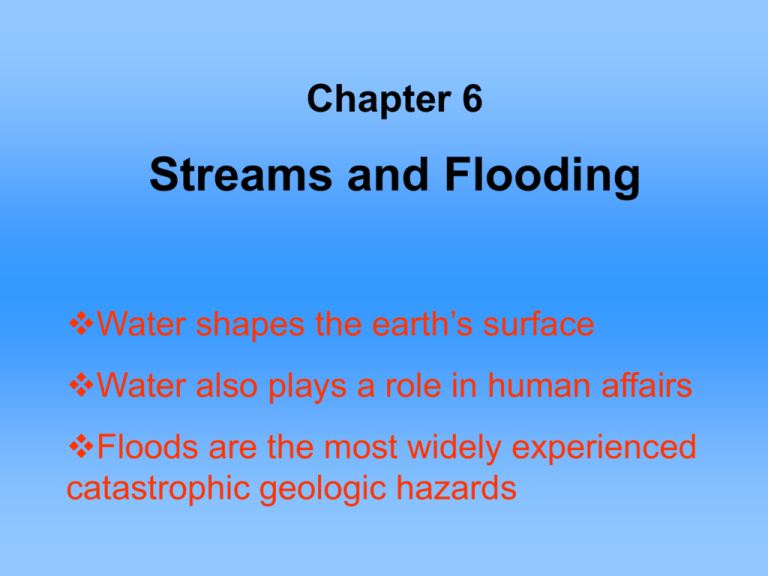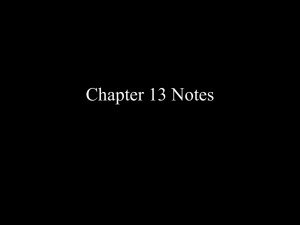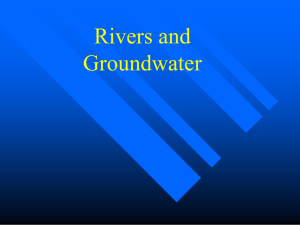Chapter 6
advertisement

Chapter 6 Streams and Flooding Water shapes the earth’s surface Water also plays a role in human affairs Floods are the most widely experienced catastrophic geologic hazards Hydrologic Cycle • Hydrosphere – all water at or near the surface of the earth • Processes involved in the cycle – Evaporation – Condensation – Precipitation – Transpiration – Runoff – Infiltration – Percolation Figure 6.1 Principal processes and reservoirs of the hydrologic cycle Water Reservoirs • • • • • • Oceans – 97.5 % Glacial Ice – 1.81 % Ground Water – 0.63 % Lakes and Streams – 0.016 % Atmosphere – 0.001% Soil Moisture – 0.005 % Streams and their Features • Stream, a flowing water within a channel • Drainage basin, a region from which a stream draws water • Discharge, the volume of water flowing past a given • • • • • point/cross section in a specified length of time Load, the total quantity of material that a stream transports by all methods (traction, saltation, suspended, and dissolved) Capacity, a measure of the total load of material a stream can move Gradient, the steepness of the stream channel Base level, the lowest elevation to which the stream can erode downward Longitudinal profile, a sketch of a stream’s elevation from source to mouth Figure 6.2 Figure 6.3 Figure 6.4 Fig. 6.05 Velocity and Sediment Sorting and Deposition • Stream velocity impacts sediment sorting – Slow moving water only carries fine-grained sediments – Swift moving water carries a wider range of grain sizes • Sediments are commonly well sorted by size and density • Depositional features of a stream – Delta, a large, fan-shaped pile of sediment in still waters created by a stream – Alluvial fan, a fan-shaped pile of sediment in a larger stream or a region between mountains and a plain formed by a small tributary stream Figures 6.6 a and b Channel and Floodplain Evolution • • • • • • Meanders, streams don’t flow in straight lines and erode old banks and create new banks, and thus bends form in the streams. Meanders are curves in a stream (or river) Cut bank, the outside and downstream side of the meander. Faster water flows Point bar, sediment deposited on the insides of meanders Braided stream, localized sediments developed in the channel with obstacles and the localized sediments divide the channel into a complex system of many channels. Floodplain, a broad, fairly flat expanse of land covered with sediment around the stream channel. An area into which the stream spills over during floods Oxbows, meanders don’t broaden or enlarge indefinitely. Streams may make a shortcut, or cut off a meander, abandoning the old, twisted channel for a direct downstream route Figure 6.7 Figure 6.8 Figure 6.9 Figures 6.10 a, b, and c Figure 6.11 Factors Governing Flooding • Input exceeds output will cause a flood – Too much water entering a stream system • Factors: – Excessive rainfall – Snowmelt off in mountains – Severe storms – Hazardous blockage of stream channel • Trees • Rock avalanches Figures 6.14 a and b Flood Characteristics • Velocity, height, and discharge of a stream increase during a flood Stage - the elevation of the water • Flood stage – stream exceeds the bank height Crest – maximum stage is reached Upstream flood –occurs in a small, localized, upper part of a basin Downstream flood – occurs in a larger, lower part of a drainage basin Flash flood – type of upstream flood characterized by a rapid rise of stream stage Stream Hydrograph • Hydrograph – a plot of stream discharge at a point over time – Records fluctuations in discharge or stream height over time – Useful tool to monitor stream behavior remotely • Hydrograph - plot discharge or stage on the vertical axis; plot time on the horizontal axis Figure 6.15 Flood-Frequency Curve • Useful tool to evaluate frequency of flood events • Long-term records very important to use of flood frequency curves – few long terms records exist • Curve is constructed by plotting discharge as a function of recurrence interval • A statistical tool only – probability information is possible • R = (N+1)/M – R = recurrence interval – N = number of years – M = ranking of annual maxima Figure 6.17 Development in a Floodplain • Reasons for floodplain occupation – Ignorance of flood hazards – Inexpensive land and often extremely beautiful • Effects of development on flood plain – – – – Asphalt and concrete - reduce infiltration Buildings - replace water volume, raises stream height Filling in floodplain land - reduces volume Storm drains - rapid delivery of storm water to streams causing increase in stream height – Vegetation loss - farm lands and urban areas remove natural vegetation and expose the soil • Streams can “silt up” • Silt reduces a streams capacity to rapidly carry water away Figure 6.19 Figure 6.21 Figure 6.20 Figure 6.23 Flood Hazard Reduction Strategies • Restrictive Zoning, similar to strategies applicable to reducing damage from seismic and other geologic hazards • Retention Pond, trap some of the surface water runoff • Diversion Channel, comes into play as stream stage rises, and redirects some of the water flow into other safe places • Channelization, various modifications of the stream channel itself to increase the velocity of water flow, the volume of the channel, or both • Levees, raised banks along a stream channel • Flood Control Dams and Reservoirs Figures 6.22 a and b Figure 6.24 Figure 6.25 Figures 6.26 a and b Figure 6.27 Figure 6.28 Figure 6.29







